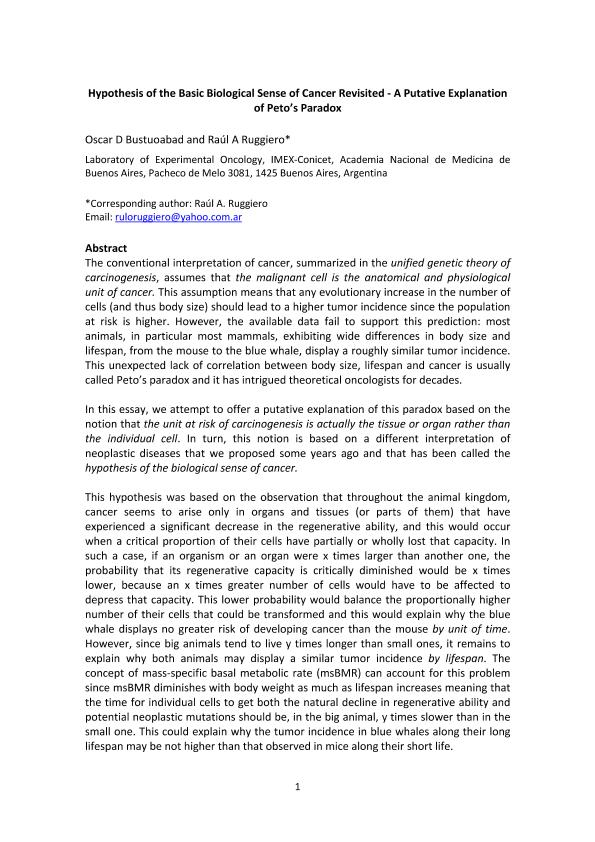Mostrar el registro sencillo del ítem
dc.contributor.author
Bustuoabad, Oscar David

dc.contributor.author
Ruggiero, Raul Alejandro

dc.date.available
2018-05-16T02:10:10Z
dc.date.issued
2017-12
dc.identifier.citation
Bustuoabad, Oscar David; Ruggiero, Raul Alejandro; Hypothesis of the basic biological sense of cancer revisited: a putative explanation of Peto's paradox; Cancer Hyphoteses; Cancer Hypotheses; 4; 9; 12-2017; 1-16
dc.identifier.uri
http://hdl.handle.net/11336/45312
dc.description.abstract
The conventional interpretation of cancer, summarized in the unified genetic theory of carcinogenesis, assumes that the malignant cell is the anatomical and physiological unit of cancer. This assumption means that any evolutionary increase in the number of cells (and thus body size) should lead to a higher tumor incidence since the population at risk is higher. However, the available data fail to support this prediction: most animals, in particular most mammals, exhibiting wide differences in body size and lifespan, from the mouse to the blue whale, display a roughly similar tumor incidence. This unexpected lack of correlation between body size, lifespan and cancer is usually called Peto?s paradox and it has intrigued theoretical oncologists for decades.In this essay, we attempt to offer a putative explanation of this paradox based on the notion that the unit at risk of carcinogenesis is actually the tissue or organ rather than the individual cell. In turn, this notion is based on a different interpretation of neoplastic diseases that we proposed some years ago and that has been called the hypothesis of the biological sense of cancer. This hypothesis was based on the observation that throughout the animal kingdom, cancer seems to arise only in organs and tissues (or parts of them) that have experienced a significant decrease in the regenerative ability, and this would occur when a critical proportion of their cells have partially or wholly lost that capacity. In such a case, if an organism or an organ were x times larger than another one, the probability that its regenerative capacity is critically diminished would be x times lower, because an x times greater number of cells would have to be affected to depress that capacity. This lower probability would balance the proportionally higher number of their cells that could be transformed and this would explain why the blue whale displays no greater risk of developing cancer than the mouse by unit of time. However, since big animals tend to live y times longer than small ones, it remains to explain why both animals may display a similar tumor incidence by lifespan. The concept of mass-specific basal metabolic rate (msBMR) can account for this problem since msBMR diminishes with body weight as much as lifespan increases meaning that the time for individual cells to get both the natural decline in regenerative ability and potential neoplastic mutations should be, in the big animal, y times slower than in the small one. This could explain why the tumor incidence in blue whales along their long lifespan may be not higher than that observed in mice along their short life.
dc.format
application/pdf
dc.language.iso
eng
dc.publisher
Cancer Hyphoteses
dc.rights
info:eu-repo/semantics/openAccess
dc.rights.uri
https://creativecommons.org/licenses/by-nc-sa/2.5/ar/
dc.subject
Biological Sense of Cancer
dc.subject
Peto´S Paradox
dc.subject
Cancer Incidence
dc.subject
Mass Specific Basal Metabolic Rate
dc.subject.classification
Otras Ciencias Biológicas

dc.subject.classification
Ciencias Biológicas

dc.subject.classification
CIENCIAS NATURALES Y EXACTAS

dc.subject.classification
Bioquímica y Biología Molecular

dc.subject.classification
Medicina Básica

dc.subject.classification
CIENCIAS MÉDICAS Y DE LA SALUD

dc.title
Hypothesis of the basic biological sense of cancer revisited: a putative explanation of Peto's paradox
dc.type
info:eu-repo/semantics/article
dc.type
info:ar-repo/semantics/artículo
dc.type
info:eu-repo/semantics/publishedVersion
dc.date.updated
2018-04-16T14:31:51Z
dc.journal.volume
4
dc.journal.number
9
dc.journal.pagination
1-16
dc.journal.pais
Reino Unido
dc.description.fil
Fil: Bustuoabad, Oscar David. Consejo Nacional de Investigaciones Científicas y Técnicas. Instituto de Medicina Experimental. Academia Nacional de Medicina de Buenos Aires. Instituto de Medicina Experimental; Argentina
dc.description.fil
Fil: Ruggiero, Raul Alejandro. Consejo Nacional de Investigaciones Científicas y Técnicas. Instituto de Medicina Experimental. Academia Nacional de Medicina de Buenos Aires. Instituto de Medicina Experimental; Argentina
dc.journal.title
Cancer Hypotheses
dc.relation.alternativeid
info:eu-repo/semantics/altIdentifier/url/http://www.cancerhypotheses.org.uk/
Archivos asociados
